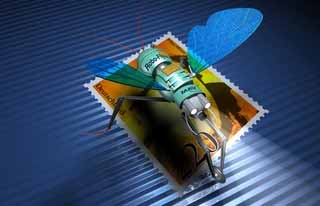
A team at the University of California, Berkeley, conducted the first flight test for an "ultra-tiny drone", with a flapping wing like a fly's.
The "robotic fly" (Robo-Fly) had a wingspan of 3 cm and weighed only 300 milligrams - like a petal of a rose flower.
On such a tiny scale, the principles of aerodynamics that "hold" an airplane in the air, do not apply. Therefore, the model based on which the "Robo-Fly" was built was a fruit fly, which flies through the air with flapping wings, at an enormous speed (hundreds of times per second!) - which allows it to move forward, and also turn on its axis in place.
The Robo-Play is built from piezoelectric ceramic materials, meaning that they expand and contract under the influence of an electric charge. Thus the movement of the wings was made possible. The maiden flight of the single-winged robotic fly was only 30 cm away. The head of the team of researchers, Albert Pisano from the Electronic Research Laboratory in Berkeley, said that "Roboplay paved the way for increased understanding of aerodynamic and mechanical systems and methods of manufacturing materials, on a micron scale."
The US Department of Defense is funding the project with the aim of using such tiny planes for reconnaissance and photography missions in future battlefields, and also to be used as weather sensors and to collect information on air flow paths, at altitudes. The real debut flight of the robo-play is planned for 2003.
The one who compared the debut of the Robo-Play to the Wright brothers' flight held at the Kittyhawk site, in 1903, emphasized that in Wright's flight, the plane they built traveled a distance of 36 meters...
